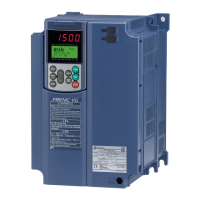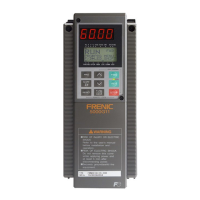6-14
[ 11 ]
dbh
Braking resistor overheated
Problem The electronic thermal protection for the braking resistor has been activated.
Possible Causes What to Check and Suggested Measures
(1) Braking load is too heavy. Reconsider the relationship between the braking load estimated and the real load.
Î Lower the real braking load.
Î Review the selection of the braking resistor and increase the braking capability
(Modification of related function code data (F50, F51, and F52) is also
required.)
(2) Specified deceleration time is
too short.
Recalculate the deceleration torque and time needed for the load currently applied,
based on a moment of inertia for the load and the deceleration time.
Î Increase the deceleration time (F08, E11, E13, E15, and H56).
Î Review the selection of the braking resistor and increase the braking capability.
(Modification of related function code data (F50, F51, and F52) is also
required.)
(3) Incorrect setting of function
code data F50, F51, and F52.
Recheck the specifications of the braking resistor.
Î Review data of function codes F50, F51, and F52, then modify them.
Note: The inverter issues an overheat alarm of the braking resistor by monitoring the magnitude of the braking load, not by
measuring its surface temperature.
When the braking resistor is frequently used so as to exceed the settings made by function codes F50, F51, and F52, therefore,
the inverter issues an overheat alarm even if the surface temperature of the braking resistor does not rise. To squeeze out full
performance of the braking resistor, configure function codes F50, F51, and F52 while actually measuring the surface
temperature of the braking resistor.
[ 12 ]
fus
Fuse blown
Problem The fuse inside the inverter blew.
Possible Causes What to Check and Suggested Measures
(1) The fuse blew due to
short-circuiting inside the
inverter.
Check whether there has been any excess surge or noise coming from outside.
Î Take measures against surges and noise.
Î Have the inverter repaired.
[ 13 ]
pbf
Charger circuit fault
Problem The magnetic contactor for short-circuiting the charging resistor failed to work.
Possible Causes What to Check and Suggested Measures
Check that, in normal connection of the main circuit (not a connection via the DC
link bus), the connector (CN R) on the power printed circuit board (power PCB) is
not inserted to NC .
Î Insert the connector (CN R) to FAN .
(1) The control power was not
supplied to the magnetic
contactor intended for
short-circuiting the charging
resistor.
Check whether you quickly turned the circuit breaker ON and OFF to confirm safety
after cabling/wiring.
Î Wait until the DC link bus voltage has dropped to a sufficiently low level and
then release the current alarm. After that, turn ON the power again. (Do not turn
the circuit breaker ON and OFF quickly.)
(Turning ON the circuit breaker supplies power to the control circuit to the
operation level (lighting the LEDs on the keypad) in a short period. Immediately
turning it OFF even retains the control circuit power for a time, while it shuts
down the power to the magnetic contactor intended for short-circuiting the
charging resistor since the contactor is directly powered from the main power.
Under such conditions, the control circuit can issue a turn-on command to the
magnetic contactor, but the contactor not powered can produce nothing. This
state is regarded as abnormal, causing an alarm.)
[ 14 ]
0ln
Overload of motor 1 through 4
Problem Electronic thermal protection for motor 1, 2, 3, or 4 activated.
0l1
Motor 1 overload
0l2
Motor 2 overload
0l3
Motor 3 overload
0l4
Motor 4 overload
Possible Causes What to Check and Suggested Measures
(1) The electronic thermal
characteristics do not match the
motor overload characteristics.
Check the motor characteristics.
Î Reconsider the data of function codes (P99*, F10* and F12*).
Î Use an external thermal relay.

